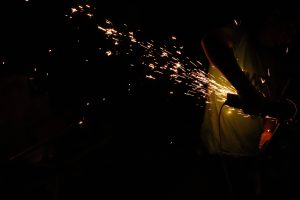Managing electrical safety in the workplace
We use so many electrical appliances every day, that often we do not give them a second thought. However, we must give a high priority to electrical safety because we work with them so frequently in our workplaces. Moreover, electricity is dangerous because the threats are unseen and are not immediately obvious.
The main hazards associated with electricity are:
- Contact between workers and an exposed live electrical part, which causes electric shock and burns
- Faults where electricity can be a source of ignition causing fires or explosion
- Burning from faulty electrical equipment may release toxic gases which can cause illness or death
- Other injuries caused by electric shocks, such as falls from ladder, scaffolds, or other elevated work platforms

Remember that electrical risks includes fire
Employers have a duty of care to eliminate electrical risks to their employees and contractors as far as is practical. If elimination is not possible, then employers need to install appropriate safety controls in place to minimise risks. All workers must be instructed and made aware of potential electrical risks before proceeding with work, including training in the controls to manage those risks.
The relevant Australian Standards for electrical safety are:
- AS/NZS 3760:2010 – In service safety inspection and testing of electrical equipment
- AS/NZS 3012:2010 – Electrical installations – Constructions and demolition sites
Where are the common sources of electrical risks and how do I manage them?
Appliances and Electrical Equipment
Electrical appliances and equipment must be obtained from a reputable manufacturer that have complied with the Gas and Electricity (Consumer Safety) Regulations 2018. Safety controls that can be used are:
- Inspect all electrical equipment before use and check for faulty or damaged plugs, switches, casing and cords. Do not use equipment differently from the manufacturer’s instructions
- Employers are required to make sure all electrical equipment are inspected, tested and tagged by a competent person or a qualified electrician according to the AS/NZS 3760: 2010 standard.
- Remove, disconnect or isolate all unsafe and damaged electrical equipment from its electricity supply. Make sure that the equipment is tagged as out of service and do no use until it is repaired and tested to be safe for use
- When cleaning electrical equipment always make sure it is disconnected from its power supply and switched off
- Do not touch electrical equipment with wet hands and do not use in damp or wet conditions unless it has been specifically designed for those conditions
- Use battery powered tools whenever possible instead of those connected to the electricity mains

Use battery powered tools when possible
The frequency of electrical inspections can vary according to the AS/NZS 3760:2010 standard. General electrical equipment should be inspected and tested at least once every 12 months. Electrical equipment used in construction and demolition sites should be inspected and tested at least once every 3 months. Electrical equipment for hire, used in commercial cleaning or in manufacturing will have a different testing frequency. More frequent testing may be needed as indicated by site-specific risk assessment.
Operating and Environmental Conditions
The operating conditions in which electrical equipment are used can also generate risks. For example, exposure to moisture, heat, vibration, mechanical damage, corrosive chemicals or dusts can lead to damage to electrical equipment. Safety controls that can be used are:
- Avoid using a power lead when possible and connect directly into a wall socket.
- When using leads make sure it is not damaged when laid out across the floor or ground. Avoid running leads over sharp edges or use lead stands or insulated cable hangers to keep leads off the ground
- Use cable protection ramps or covers to protect cable and cords
- When working outdoors, use extension cables that are rated for outdoor use
- Provide enough power sockets so that socket outlets are not overloaded with adaptors. Never piggyback a double adapter
- Do not overload a power board with too many electrical equipment. Always use a power board with in-built safety devices (such as overload switches)
- Check that there are no live electrical wires before drilling into walls
- Check that there are no underground power cables before digging or excavating a trench
- Check for overhead power lines before working at heights, such as working on a roof or on an elevated work platform

Workers need to take extreme care when working near overhead power lines
Ensure that all electrical work is carried out only by qualified persons or licensed electricians. Employers should ensure Residual Current Devices (RCDs) are installed wherever workers are using a ‘plug in’ electrical equipment. RCDs, also called ‘safety switches’, are devices designed to cut off power flow during an emergency. Whenever employees are working in a client site, they can use portable RCDs to use with their plug-in equipment.
There is no question that electricity and electrical equipment have played a major part in changing how we work. Our lives are made infinitely easier compared to our ancestors, thanks to the devices we use today. Whilst it can be extremely dangerous, with the right safety systems in place electricity can continue to be a powerful ally in our lives.
For more information on Electrical Safety consult the SafeWork NSW website. Since the complexity of the potential risks can vary, employers may need to contact a Work, Health and Safety Consultant to discuss their specific needs.











